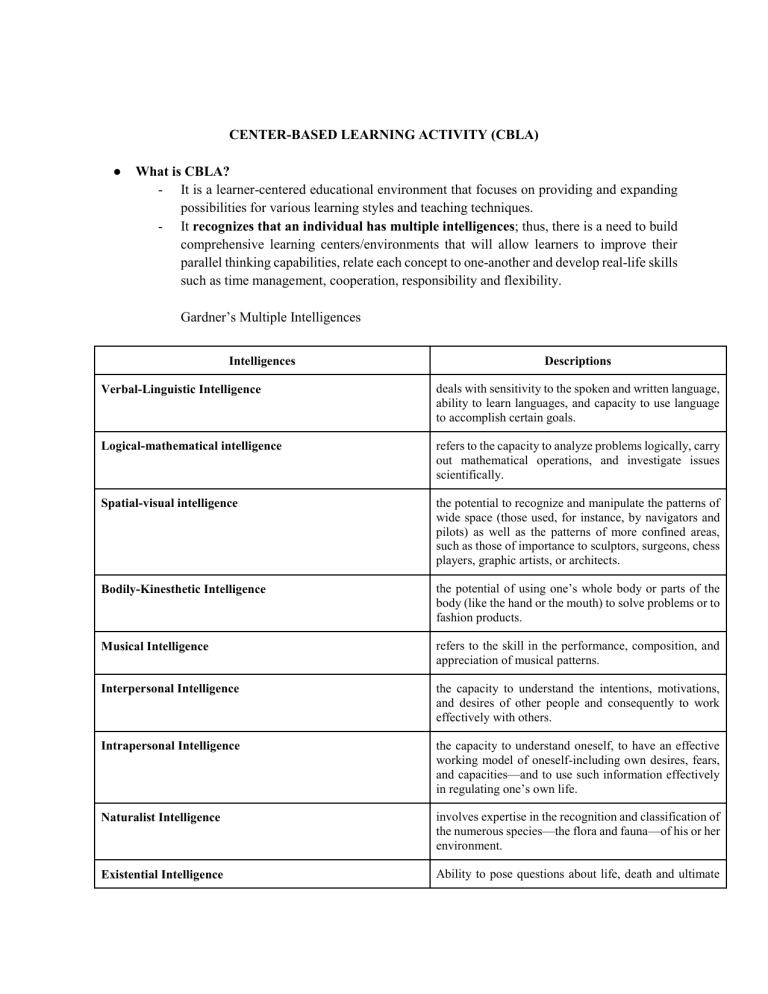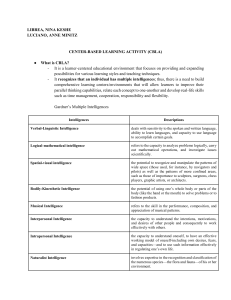
CENTER-BASED LEARNING ACTIVITY (CBLA) ● What is CBLA? - It is a learner-centered educational environment that focuses on providing and expanding possibilities for various learning styles and teaching techniques. - It recognizes that an individual has multiple intelligences; thus, there is a need to build comprehensive learning centers/environments that will allow learners to improve their parallel thinking capabilities, relate each concept to one-another and develop real-life skills such as time management, cooperation, responsibility and flexibility. Gardner’s Multiple Intelligences Intelligences Descriptions Verbal-Linguistic Intelligence deals with sensitivity to the spoken and written language, ability to learn languages, and capacity to use language to accomplish certain goals. Logical-mathematical intelligence refers to the capacity to analyze problems logically, carry out mathematical operations, and investigate issues scientifically. Spatial-visual intelligence the potential to recognize and manipulate the patterns of wide space (those used, for instance, by navigators and pilots) as well as the patterns of more confined areas, such as those of importance to sculptors, surgeons, chess players, graphic artists, or architects. Bodily-Kinesthetic Intelligence the potential of using one’s whole body or parts of the body (like the hand or the mouth) to solve problems or to fashion products. Musical Intelligence refers to the skill in the performance, composition, and appreciation of musical patterns. Interpersonal Intelligence the capacity to understand the intentions, motivations, and desires of other people and consequently to work effectively with others. Intrapersonal Intelligence the capacity to understand oneself, to have an effective working model of oneself-including own desires, fears, and capacities—and to use such information effectively in regulating one’s own life. Naturalist Intelligence involves expertise in the recognition and classification of the numerous species—the flora and fauna—of his or her environment. Existential Intelligence Ability to pose questions about life, death and ultimate realities like “Who are we” and “What is the meaning of life” - Learners can work individually, in pairs, small groups and as a class. It emphasizes both teamwork and individual work. The MG classroom provides a variety of topics and activities that can be arranged for concept-based or theme-based teaching. ● Guidelines in Center-based Learning Activity: 1. Consider a theme of interest 2. After deciding, ask the following questions: ❖ Linguistics - How can I use the spoken word? ❖ Logical/mathematical - How can I bring numbers? ❖ Spatial - How can I use visual aids? ❖ Bodily-kinesthetic - how can I use the whole body? ❖ Musical - How can I bring music? ❖ Interpersonal - How can I engage learners in group works? ❖ Intrapersonal - How can I evoke personal feelings? ❖ Naturalistic - How can I bring in nature? ❖ Existential - How can I bring in philosophical questions? 3. Create centers in the classroom with materials that are appropriate for each identified multiple intelligences. EXAMPLE: REFERENCE: Marenus, M. (2023). Howard Gardner's Theory of Multiple Intelligences. Simply Psychology. https://www.simplypsychology.org/multiple-intelligences.html Montalbo, I., Iradel, C., & Perez, N. (2022). Teaching Multigrade Classes. Lorimar Publishing Inc.



